Driving The Polaris Slingshot Was So Unpleasant It Set Off My Fitness Tracker's Stress Monitor

Jalopnik is more than just a car blog. We cover and review all sorts of transportation, from boats to trains to motorcycles, but this review is of something much more nebulous: The Polaris Slingshot. You know, that three-wheeled, two-seat, open-topped tricycle thing with a single belt-driven rear wheel. My apprehensions ran high prior to driving this Volt Orange 2024 Polaris Slingshot SL, and after a week living with the Slingshot, those apprehensions were validated. The Slingshot really isn’t for me.
What’s Better Than an E-Bike? An E-Trike
Full disclosure: I’ve seen Polaris Slingshots terrorizing the streets of LA for years now, and I can honestly say that I never thought I’d drive one, but the generous folks at Polaris changed that. They loaned me a Volt Orange 2024 Polaris Slingshot SL with a five-speed manual transmission and two helmets, and this is how it went.
Photo: Logan K. Carter
Hopping into the Slingshot requires you to step over the tube frame structure on the side of the vehicle, as there are no doors. Once you get into the seat there’s a surprising amount of legroom, almost enough for my 6-foot-8-inch frame to fit comfortably. Almost. Of course, headroom is a non-issue since there’s no roof over your head, but because Polaris requires anyone riding in one of their press cars to wear a helmet, I didn’t get the wind-in-your-hair feeling I had hoped for as a lover of convertibles. Weirdly, both of the Slingshot’s seatbelts are anchored in the center of the vehicle, so as the driver you have to reach over your right shoulder to grab the belt and buckle it on your left side. This decision paired with the lack of doors and lack of adequate seat bolsters amplifies the already perilous feeling of piloting a Polaris.
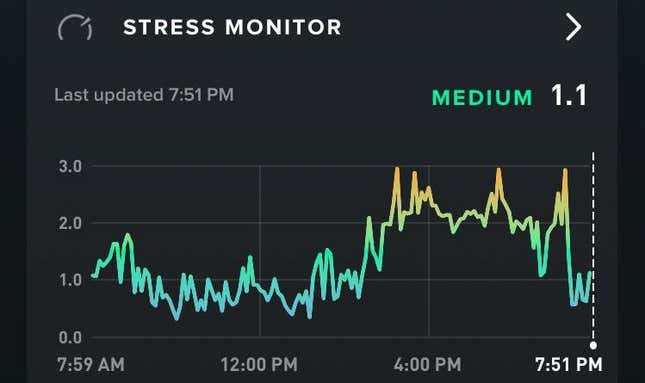
Guess when I was driving the SlingshotPhoto: Logan K. Carter
Driving the Slingshot through LA is a stressful experience, as proven by my Whoop fitness watch tracking all of my drives as times of elevated stress. You sit very low to the ground, with no airbags, no doors and no roof. The engine is thrashy to the fullest extent of the word, yet gutless until its 8,500-rpm redline where it finally makes peak horsepower. The clutch is stiff and heavy, the transmission tunnel gets concerningly hot to the touch while you’re driving, the ride is harsh, and because the Slingshot is such an unusual shape, it’s hard to gauge where the vehicle begins and where it ends. All of these factors contributed to my elevated stress levels from behind the Slingshot’s tiny steering wheel, combined with the knowledge that any one of the three-row mommy mobiles on Los Angeles roads could run me over without even noticing.
The Polaris-built 2.0-liter inline-4 engine in the Slingshot SL is rated at 178 horsepower and just 120 pound-feet of torque, the latter of which hits its peak at 5,500 rpm, and the Slingshot weighs just 1,633 pounds in total, nearly 1,000 pounds less than a Mazda Miata. This should make it a ton of fun to drive, but as soon as the power builds it just spins that single driven rear wheel, which can make you smile if you don’t need it to hook up. And it’s far from fast, and the engine’s demeanor is conflicting. You have to rev it out to redline to get power, but the engine is so rattly it sounds like it’s going to blow up. I was not a fan of the exhaust note either, since it sounded more like a leaf blower than a car, which might be excusable in a side-by-side, but not in something that’s meant to be an on-road fun machine.
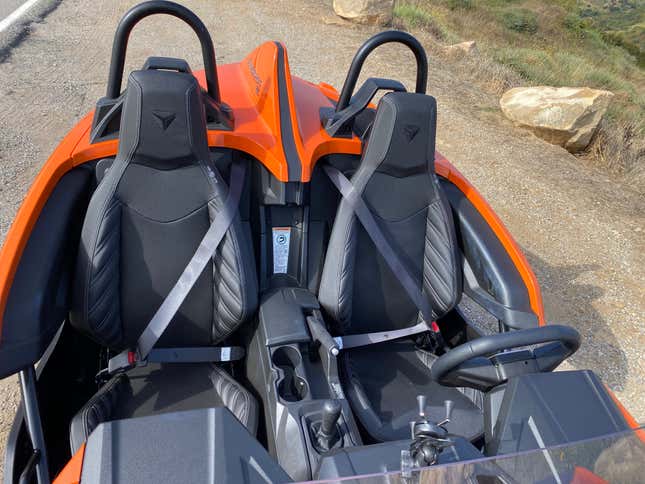
Photo: Logan K. Carter
Driving the Slingshot on winding roads was also a harrowing experience. My canyon road of choice had some occasional debris, which would cause the Slingshot to lose traction no matter how slow I was going. In one situation there was a little stripe of dirt in the center of my lane on a curve; I slowed down to 10 mph and still nearly slid off the cliff because the rear wheel hit the dirt and lost traction in a big way. Thankfully, the Slingshot does have traction control and ABS, but the single rear wheel makes it too volatile to be trustworthy enough for me to push it on twisty mountain roads. It’s also unreasonably difficult to judge the width of the thing, because the front end is freakishly wide and the rear is freakishly narrow, so threading the needle becomes an exercise of faith and elevated cortisol levels.
My tester came with the no-cost 5-speed manual transmission, which made the driving experience more engaging but still had its faults. The transmission is notchy and feels just fine to shift, but the high-revving character of the Polaris engine doesn’t match well with the gear ratios. First to second gear is fine, but when you shift into third gear the RPMs fall so drastically that it drops you right out of the power band and the car bogs down.

Photo: Logan K. Carter
“So what about cruising on the world famous Pacific Coast Highway,” you might ask, “if it isn’t any good in the twisties maybe it’s at least a good cruiser?” Nope. There’s no time when you can relax behind the wheel of the Slingshot. The rear wheel feels like it’s constantly bouncing around, requiring endless steering inputs to keep it centered in the lane. Wearing a helmet makes the cruising experience even less relaxing. If you get stuck in traffic, you’ll start cooking in the sun, you’ll get gassed out by the smelly exhaust, and your left leg will start cramping from the heavy clutch.
The seats on my tester were heated and cooled, which is a welcome option. Unfortunately, when combined with seatbelts that are tethered in the middle of the vehicle instead of over the occupants’ outside shoulder like in every other car, it felt like I was about to slide out of the Slingshot around every corner. Other creature comforts include Apple CarPlay that requires a bluetooth headset to be connected to allow operation, so I never tried it.
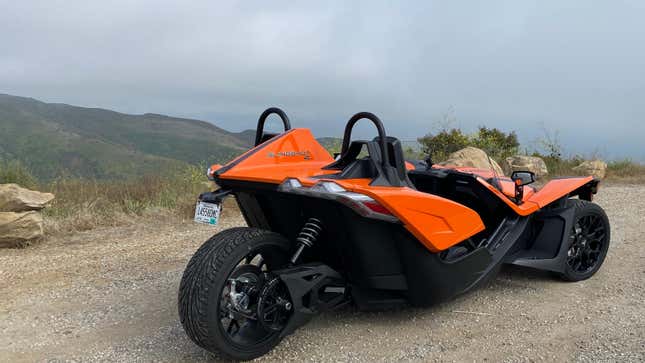
Photo: Logan K. Carter
My test vehicle came with minimal options, including heated and cooled seats for $1,629.99, a $100 phone mount, and a $549.99 navigation and CarPlay package, bringing the total MSRP to $30,428.97. The cheapest new Slingshot S sells for $21,999 without any options, and the most expensive Slingshot Roush Edition starts at $38,149 before any options. In my opinion, there are a litany of better ways to spend $30,000, like buying hair plugs and a face lift as an alternative way to prove to the world that you still got it, or by buying a used sports car, or $30,000 of lottery tickets.
Overall, I’m not a fan of the Polaris Slingshot, but then I don’t think I’m the target audience. What is the target audience, you may ask? Beats me, but people buy them and seem to love them, so if you swoon when you see a Slingshot drive by, go try one. There’s certainly nothing quite like the experience of driving a Polaris Slingshot, for better or for worse.
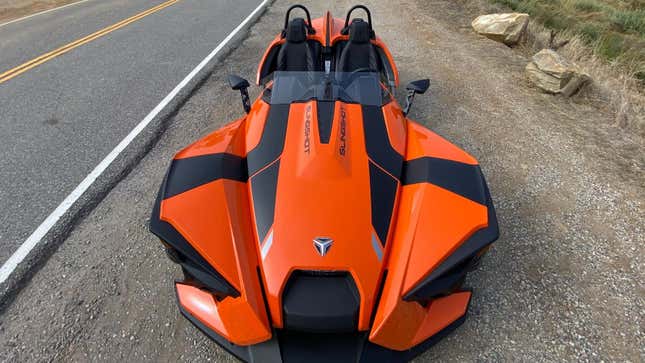
Photo: Logan K. Carter
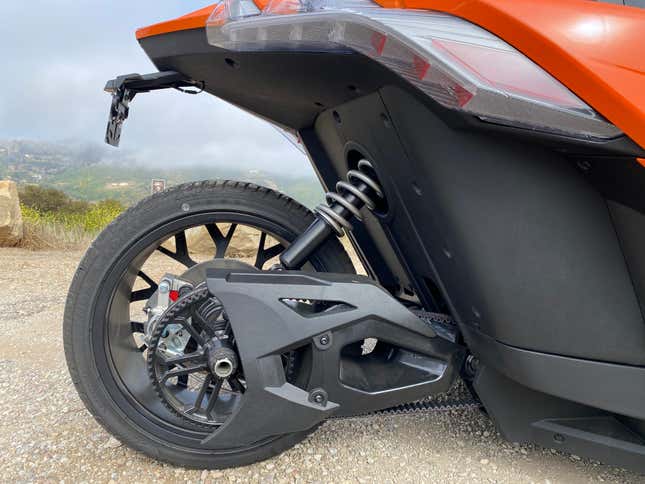
Photo: Logan K. Carter
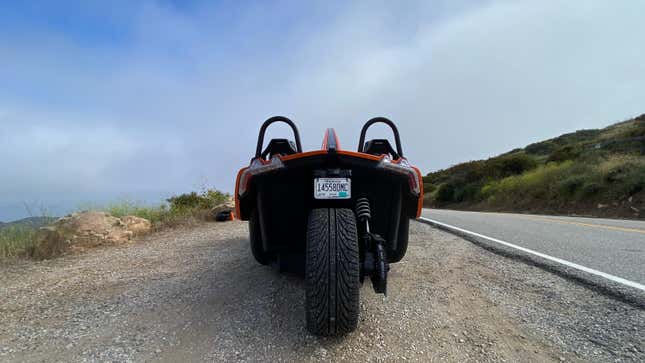
Photo: Logan K. Carter







